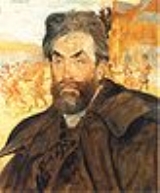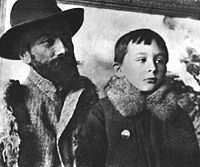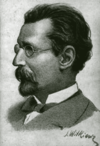
Stanislaw Witkiewicz
Encyclopedia
- For his son, the writer who lived 1885–1939, see Stanisław Ignacy Witkiewicz.

Pašiaušė
Pašiaušė is a village in Lithuania, between Šiauliai and Panevėžys. According to census of 2001, it had 215 residents....
– 5 September 1915 in Lovran
Lovran
Lovran is a town in Istria, Croatia. It is situated on the western coast of the Kvarner Bay with a population of 3,241 . Its name derives from Laurel , as shown in the coat of arms....
) was a Polish
Poland
Poland , officially the Republic of Poland , is a country in Central Europe bordered by Germany to the west; the Czech Republic and Slovakia to the south; Ukraine, Belarus and Lithuania to the east; and the Baltic Sea and Kaliningrad Oblast, a Russian exclave, to the north...
painter
Painting
Painting is the practice of applying paint, pigment, color or other medium to a surface . The application of the medium is commonly applied to the base with a brush but other objects can be used. In art, the term painting describes both the act and the result of the action. However, painting is...
, architect
Architecture
Architecture is both the process and product of planning, designing and construction. Architectural works, in the material form of buildings, are often perceived as cultural and political symbols and as works of art...
, writer
Literature
Literature is the art of written works, and is not bound to published sources...
and art theoretician.
Life
Witkiewicz was born in the LithuaniaLithuania
Lithuania , officially the Republic of Lithuania is a country in Northern Europe, the biggest of the three Baltic states. It is situated along the southeastern shore of the Baltic Sea, whereby to the west lie Sweden and Denmark...
n village of Pašiaušė
Pašiaušė
Pašiaušė is a village in Lithuania, between Šiauliai and Panevėžys. According to census of 2001, it had 215 residents....
in Samogitia
Samogitia
Samogitia is one of the five ethnographic regions of Lithuania. It is located in northwestern Lithuania. Its largest city is Šiauliai/Šiaulē. The region has a long and distinct cultural history, reflected in the existence of the Samogitian dialect...
, at that time, in the partitioned
Partitions of Poland
The Partitions of Poland or Partitions of the Polish–Lithuanian Commonwealth took place in the second half of the 18th century and ended the existence of the Polish–Lithuanian Commonwealth, resulting in the elimination of sovereign Poland for 123 years...
Polish-Lithuanian Commonwealth
Polish-Lithuanian Commonwealth
The Polish–Lithuanian Commonwealth was a dualistic state of Poland and Lithuania ruled by a common monarch. It was the largest and one of the most populous countries of 16th- and 17th‑century Europe with some and a multi-ethnic population of 11 million at its peak in the early 17th century...
lands ruled by the Russian Empire
Russian Empire
The Russian Empire was a state that existed from 1721 until the Russian Revolution of 1917. It was the successor to the Tsardom of Russia and the predecessor of the Soviet Union...
.
Witkiewicz studied in Saint Petersburg
Saint Petersburg
Saint Petersburg is a city and a federal subject of Russia located on the Neva River at the head of the Gulf of Finland on the Baltic Sea...
, 1869–71, then in Munich
Munich
Munich The city's motto is "" . Before 2006, it was "Weltstadt mit Herz" . Its native name, , is derived from the Old High German Munichen, meaning "by the monks' place". The city's name derives from the monks of the Benedictine order who founded the city; hence the monk depicted on the city's coat...
, 1872–75.
He created the Zakopane Style (styl zakopiański) (also known as Witkiewicz Style (styl witkiewiczowski)) in architecture. He was strongly associated with Zakopane
Zakopane
Zakopane , is a town in southern Poland. It lies in the southern part of the Podhale region at the foot of the Tatra Mountains. From 1975 to 1998 it was in of Nowy Sącz Province, but since 1999 it has been in Lesser Poland Province. It had a population of about 28,000 as of 2004. Zakopane is a...
and promoted it in the art community.

Conflation
Conflation occurs when the identities of two or more individuals, concepts, or places, sharing some characteristics of one another, become confused until there seems to be only a single identity — the differences appear to become lost...
of his surname
Surname
A surname is a name added to a given name and is part of a personal name. In many cases, a surname is a family name. Many dictionaries define "surname" as a synonym of "family name"...
and middle name
Middle name
People's names in several cultures include one or more additional names placed between the first given name and the surname. In Canada and the United States all such names are specifically referred to as middle name; in most European countries they would simply be regarded as second, third, etc....
) by the mononymous pseudonym "Witkacy." The son's godmother was the internationally famous actress Helena Modjeska
Helena Modjeska
Helena Modjeska Helena Modjeska Helena Modjeska (October 12, 1840 – April 8, 1909, whose actual Polish surname was Modrzejewska , was a renowned actress who specialized in Shakespearean and tragic roles.Modjeska was the mother of Polish-American bridge engineer Ralph Modjeski....
(Helena Modrzejewska), whom the elder Witkiewicz in 1876 had nearly accompanied to California
California
California is a state located on the West Coast of the United States. It is by far the most populous U.S. state, and the third-largest by land area...
in the United States
United States
The United States of America is a federal constitutional republic comprising fifty states and a federal district...
.
Witkiewicz had strong views against formal education
Education
Education in its broadest, general sense is the means through which the aims and habits of a group of people lives on from one generation to the next. Generally, it occurs through any experience that has a formative effect on the way one thinks, feels, or acts...
: "school is completely at odds with the psychological make-up of human beings". He applied this principle in his son's upbringing and was disappointed when the 20-year-old Witkacy chose to enroll at the Academy of Fine Arts
Jan Matejko Academy of Fine Arts
The Jan Matejko Academy of Fine Arts, or Kraków Academy of Fine Arts , located in Kraków, Poland, is the oldest Polish fine-arts academy, established in 1818.It is a state-run university that offers 5- and 6-year Master's degree programs...
in Kraków
Kraków
Kraków also Krakow, or Cracow , is the second largest and one of the oldest cities in Poland. Situated on the Vistula River in the Lesser Poland region, the city dates back to the 7th century. Kraków has traditionally been one of the leading centres of Polish academic, cultural, and artistic life...
.
In 1908, suffering from tuberculosis
Tuberculosis
Tuberculosis, MTB, or TB is a common, and in many cases lethal, infectious disease caused by various strains of mycobacteria, usually Mycobacterium tuberculosis. Tuberculosis usually attacks the lungs but can also affect other parts of the body...
, the elder Witkiewicz left his family in Zakopane and relocated to Lovranno, a fashionable resort in what was then Austria-Hungary
Austria-Hungary
Austria-Hungary , more formally known as the Kingdoms and Lands Represented in the Imperial Council and the Lands of the Holy Hungarian Crown of Saint Stephen, was a constitutional monarchic union between the crowns of the Austrian Empire and the Kingdom of Hungary in...
, which today is in Croatia
Croatia
Croatia , officially the Republic of Croatia , is a unitary democratic parliamentary republic in Europe at the crossroads of the Mitteleuropa, the Balkans, and the Mediterranean. Its capital and largest city is Zagreb. The country is divided into 20 counties and the city of Zagreb. Croatia covers ...
. He died there in 1915.
See also

- ImpressionismImpressionismImpressionism was a 19th-century art movement that originated with a group of Paris-based artists whose independent exhibitions brought them to prominence during the 1870s and 1880s...
- LandscapeLandscape artLandscape art is a term that covers the depiction of natural scenery such as mountains, valleys, trees, rivers, and forests, and especially art where the main subject is a wide view, with its elements arranged into a coherent composition. In other works landscape backgrounds for figures can still...
- Realism
- Tatra mountainsTatra MountainsThe Tatra Mountains, Tatras or Tatra , are a mountain range which forms a natural border between Slovakia and Poland, and are the highest mountain range in the Carpathian Mountains...
- List of Poles

